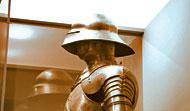Given the chance I will usually look at suits of armor. I love the samurai armor in the Pavilion for Japanese Art, often visit the Arms and Armor galleries when at the Met, and lately have been studying the four shining examples in the Hearst exhibition, trying to figure out what makes them interesting. I began with the thesis that they're funny, but that's not it: they're more strange than funny, the original Transformers, an alien version of the human form. Hearst the Collector is a great place to ponder the contrast; the armored figures stand like sentinels at an intersection that leads in every direction to images of graceful humans, or goddesses in human form.
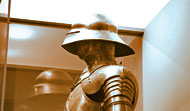
Armor in the Gothic Style, Germany (Augsburg), c. 1485 and later (detail), The Detroit Institute of Arts, gift of the Hearst Corporation

The Hope Hygieia, Rome, mid-2nd century (detail), LACMA, William Randolph Hearst Collection
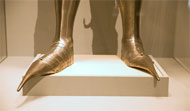
Armor in the Gothic Style, Germany (Augsburg), c. 1485 and later (detail), The Detroit Institute of Arts, gift of the Hearst Corporation
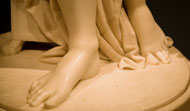
Antonio Canova, Italy, Venus Italica, c. 1804-14 (detail), Hearst Castle/California State Parks
•
The other thing that interests me about armor is: it seems like it would be difficult to fight while wearing it—hard to move and even harder to see what you're doing. I've researched this a bit and am amazed to find a scholar who sort of agrees. In A History of Warfare, the historian John Keegan writes,
Indeed, there is considerable evidence that, even in its heyday in the fifteenth century, knightly warfare was not what it seems to us or what its devotees believed it ought to be at the time.... The idea that armoured knights, riding knee to knee with couched lances in dense waves of successive ranks, could have charged home against each other without instantaneous catastrophe to both sides at the moment of impact defies belief.
Keegan thinks plate armor was less suited to combat than to "the artificialities of the joust."
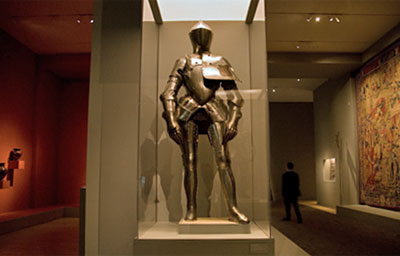
Armor for the Tilt, Germany (Augsburg), c. 1580, The Detroit Institute of Arts, Gift of the William Randolph Hearst Foundation
And yet, not so fast. The Met's excellent FAQ on armor says that the immobility of knights in armor is a misconception—that field armor weighs less than the things modern soldiers carry and that "the famous French knight Jean de Maingre (ca. 1366-1421) known as Maréchal Boucicault... in full armor, was able to climb up the underside of a ladder using only his hands." And I find that pretty fascinating too.



